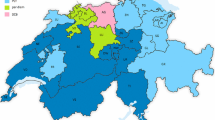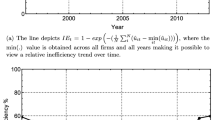Abstract
Several European countries have followed the USA in introducing prospective payment for hospitals with the expectation of achieving cost efficiency gains. This article examines whether theoretical expectations of cost efficiency gains can be empirically confirmed. In contrast to previous studies, the analysis of hospitals in Switzerland provides a comparison of a retrospective per diem payment system with a prospective global budget and a payment per patient case system. Using a sample of approximately 90 public financed Swiss hospitals during the years 2004–2009 and Bayesian inference of a standard and a random parameter frontier model, cost efficiency gains are found, particularly with payment per patient case. Prospective payment, designed to put hospitals at operating risk, is more effective in terms of cost reduction than the retrospective alternative. However, hospitals are heterogeneous with respect to their production technologies, making a random parameter frontier model the superior specification for Switzerland.



Similar content being viewed by others
Notes
Health insurers cover more than 45 % of operating costs in the case of privately owned hospitals which are not on the cantonal list. However, these are typically for-profit hospitals specializing in the treatment of patients having supplementary insurance coverage.
Diagnostic Related Groups (DRGs) are a diagnosis classification system, designed to reflect resource requirements in hospital treatment. In Switzerland, AP-DRG, a non-profit organization, was created to define diagnostic groups and to establish their cost weights. In 2012, SwissDRG replaced the AP-DRG system.
It is worth mentioning that modeling technology as an exogenous determinant of operating cost may not always be appropriate. To the extent that it reflects a choice by hospital management, the presence of an inferior technology amounts to an inefficiency.
In principle, one could also allow for individual cost functions in the RPFM [38]. But for the time being, payment negotiations in Switzerland do not involve hospitals individually but rather by category. Therefore, category-specific estimates are presented in this paper.
Technology parameters of models 2 and 3 are not shown. They are found to be comparable to those discussed in Sect. 5.1.
References
Aigner, D., Lovell, C.A.K., Schmidt, P.: Formulation and estimation of stochastic frontier production function models. J. Econ. 6(1), 21–37 (1977)
Battese, G.E., Coelli, T.J.: A model for technical inefficiency effects in a stochastic frontier production function for panel data. Empir. Econ. 20(2), 325–332 (1995)
Biorn, E., Hagen, T.P., Iversen, T., Magnussen, J.: The effect of activity-based financing on hospital efficiency: A panel data analysis of DEA efficiency scores 1992–2000. Health Care Manag. Sci. 6, 271–283 (2003)
Biorn, E., Hagen, T.P., Iversen, T., Magnussen, J.: Heterogeneity in hospitals’ responses to a financial reform: a random coefficient analysis of the impact of activity-based financing on efficiency. Working paper 8100, University Library of Munich, Germany (2006)
Biorn, E., Hagen, T.P., Iversen, T., Magnussen, J.: How different are hospitals’ responses to a financial reform? The impact on efficiency of activity-based financing. Health Care Manag. Sci. 13(1), 1–16 (2010)
Borden, J.P.: An assessment of the impact of diagnosis-related group (DRG)-based reimbursement on the technical efficiency of New Jersey hospitals using data envelopment analysis. J. Account. Pub. Policy 7(2), 77–96 (1988)
Chalkley, M., Malcomson, J.M.: Contracting for health services when patient demand does not reflect quality. J. Health Econ. 17(1), 1–19 (1998)
Chalkley, M., Malcomson, J.M.: Government purchasing for health services. In: Culyer, A.J., Newhouse, J.P. (eds.) Handbook of Health Economics, vol. 1A, pp. 847–889. Elsevier, Amsterdam (2000)
Chern, J.-Y., Wan, T.T.H.: The impact of the prospective payment system on the technical efficiency of hospitals. J. Med. Syst. 24, 159–172 (2000)
Coelli, T., Rao, D.S.P., O’Donnell, C.J., Battese, G.E.: An Introduction to Efficiency and Productivity Analysis. Springer, Berlin (2005)
Dismuke, C., Sena, V.: Has the DRG system influenced the efficiency of diagnostic technology in Portugal? An empirical analysis using parametric and non-parametric methods. Health Care Manag. Sci. 2, 107–116 (1999)
Farsi, M., Filippini, M.: An analysis of efficiency and productivity in Swiss hospitals. Swiss J. Econ. Stat. (SJES) 142(I), 1–37 (2006)
Farsi, M., Filippini, M., Greene, W.: Application of panel data models in benchmarking analysis of the electricity distribution sector. Ann. Pub. Coop. Econ. 77(3), 271–290 (2006)
Filippini, M., Farsi, M., Crivelli, L., Zola, M.: An analysis of efficiency and productivity in Swiss hospitals. Report, Swiss Federal Statistical Office (2004)
Greene, W.: Distinguishing between heterogeneity and inefficiency: stochastic frontier analysis of the World Health Organization’s panel data on national health care systems. Health Econ. 13(10), 959–980 (2004)
Griffin, J., Steel, M.: Bayesian stochastic frontier analysis using WinBUGS. J. Product. Anal. 27, 163–176 (2007)
Herwartz, H., Strumann, C.: Hospital efficiency under prospective reimbursement schemes: an empirical assessment for the case of germany. Eur. J. Health Econ. 1–12 (2013). doi:10.1007/s10198-013-0464-5
Huang, C., Liu, J.: Estimation of a non-neutral stochastic frontier production function. J. Product. Anal. 5, 68–80 (1994)
Koop, G., Osiewalski, J., Steel, M.F.J.: Bayesian efficiency analysis through individual effects: hospital cost frontiers. J. Econom. 76(1–2), 77–105 (1997)
Kumbhakar, S., Lovell, C.A.K.: Stochastic Frontier Analysis: An Econometric Approach. Cambridge University Press, Cambridge (2000)
Kumbhakar, S.C., Ghosh, S., McGuckin, J.T.: A generalized production frontier approach for estimating determinants of inefficiency in U.S. dairy farms. J. Bus. Econ. Stat. 9(3), 279–286 (1991)
Linna, M.: The impact of health care financing reform on the productivity change in Finnish hospitals. System Analysis Laboratory, Research Reports 79(A) (1999)
Meeusen, W., van den Broeck, J.: Efficiency estimation from Cobb-Douglas production functions with composed error. Int. Econ. Rev. 18(2), 435–444 (1977)
Meister, U.: Hospitals between regulation and competition (Spitäler zwischen Politik und Wettbewerb: Betriebliche Autonomie im Kantonsvergleich). Report, Avenir Suisse (2008)
Morey, R., Dittman, D.: Cost pass-through reimbursement to hospitals and their impacts on operating efficiencies. Ann. Oper. Res. 67, 117–139 (1996)
Newhouse, J.P.: Reimbursing health plans and health providers: efficiency in production versus selection. J. Econ. Lit 34(3), 1236–1263 (1996)
Ntzoufras, I.: Bayesian Modeling Using WinBUGS. Wiley Series in Computational Statistics. Wiley, Hoboken NJ (2009)
Orea, L., Kumbhakar, S.C.: Efficiency measurement using a latent class stochastic frontier model. Empir. Econ. 29(1), 169–183 (2004)
O’Reilly, J., Busse, R., Häkkinen, U., Or, Z., Street, A., Wiley, M.: Paying for hospital care: the experience with implementing activity-based funding in five European countries. Health Econ. Policy Law 7(01), 73–101 (2012)
Schneider, P.: Provider payment reforms: lessons from Europe and America for South Eastern Europe. Discussion paper, World Bank, Washington (2007)
Simar, L., Wilson, P.W.: Statistical inference in nonparametric frontier models: the state of the art. J. Product. Anal. 13, 49–78 (2000)
Smith, P.C.: Health care reforms in Europe and their implications for Japan. Jpn. J. Soc. Secur. Policy 3(2), 80–95 (2004)
Sommersguter-Reichmann, M.: The impact of the Austrian hospital financing reform on hospital productivity: empirical evidence on efficiency and technology changes using a non-parametric input-based malmquist approach. Health Care Manag. Sci. 3(4), 309–321 (2000)
Spiegelhalter, D.J., Best, N.G., Carlin, B.P., van der Linde, A.: Bayesian measures of model complexity and fit. J. R. Stat. Soc. Ser. B 64, 583–640 (2002)
Steinmann, L., Zweifel, P.: On the (in)efficiency of Swiss hospitals. Appl. Econom. 35(3), 361–370 (2003)
Street, A., O’Reilly, J., Padriac Ward, A.M.: Drg-based hospital payment and efficiency: theory, evidence, and challenges. In: Busse, R., Geissler, A., Quentin, W., Wiley, M. (eds.) Diagnosis-Related Groups in Europe: Moving Towards Transparency, Efficiency and Quality in Hospitals. Open University Press, Maidenhead, pp. 93–114 (2010)
Tsionas, E.G.: Stochastic frontier models with random coefficients. J. Appl. Econ. 17(2), 127–147 (2002)
Widmer, P.K., Zweifel, P., Farsi, M.: Accounting for heterogeneity in the measurement of hospital performance. Working paper ECON 52, Department of Economics, University of Zürich (2011)
Zweifel, P., Tai-Seale, M.: An economic analysis of payment for health care services: the United States and Switzerland compared. Int. J. Health Care Financ. Econ. 9(2), 197–210 (2009)
Author information
Authors and Affiliations
Corresponding author
Additional information
The author would like to thank Peter Zweifel for his valuable support.
Appendix: Specifications for Bayesian estimation
Appendix: Specifications for Bayesian estimation
This paper uses Bayesian inference to estimate Eqs. (1) and (3). Inference is made from a posterior distribution \(p(\theta |X)\) of the unknown parameters (denoted by \(\theta\)) given the observed data (summarized as \(X\)). According to the Bayesian rule, this posterior distribution is given by
It is the product of the prior distribution \(p(\theta )\) and the likelihood \(\mathcal {L}(X|\theta )\), respectively.
For the estimates reported in Sect. 5, the posterior distribution pertaining to the SFM is specified as
where \(p(\alpha ,\beta ,\gamma ,\sigma _v^{-2}, \sigma _u^{-2})\) are probability distributions of the unknown parameters. The likelihood function in Eq. (10) is as in [16], i.e., normally distributed with \(\sigma _v^2\) which denotes the variance of the random noise \(v_{it}=C_{it}-[C(Y_{it},W_{it};\alpha ,\beta )+u_{it}]\). Equation (10) affords gain in flexibility over classical maximum likelihood estimation which requires a joint density function of the random noise and the inefficiency term to be specified. Here, only random noise enters the likelihood function. Inefficiency is estimated hierarchically as a latent variable along with the other parameters of the cost frontier.
Turning to the RPFM, the posterior is given by
Again, the likelihood function is specified as a normal distribution and inefficiency is estimated as a latent variable together with the other unknown parameters. The difference from Eq. (10) lies in the specification of the random intercept \(\alpha _j\) and the slope parameters \(\beta _j\), which are estimated at two levels. At the first level, overall determinants of hospital cost (\(\bar{\alpha }\), \(\bar{\beta }\)) are taken into account, corresponding to the first factor following the proportionally sign of Eq. (11). The second-level estimates concern the effects (\(\alpha _{j}\), \(\beta _{j}\)) associated with six hospital categories as defined in Eq. (4). They are derived from the multivariate normal distribution shown in Eq. (11).
In contrast to classical inference, Bayesian estimation requires information regarding the prior distributions of the unknown parameters, which are considered as random variables. These priors should comprise all information available before the sample data are used. In this paper, the values for the hyperparameters characterizing priors are chosen in a way to imply appropriate priors without imposing excessive restrictions. In particular, the priors for the SFM and RPFM are assumed to be independent,
Here, \(p(\alpha )=f_N[0,\theta _{\alpha }]\), \(p(\bar{\alpha })=f_N[0,\theta _{\bar{\alpha }}]\), \(p(\beta )=f_N[0,\theta _{\beta }]\), \(p(\bar{\beta })=f_N[0,\theta _{\bar{\beta }}]\) all have a normal distribution with mean zero and a diffuse prior for their corresponding variance \(\theta\). The variance of the likelihood function has a gamma distribution \(p(\sigma _v^{-2})=f_G[\mu ,\theta _{\sigma _v^{-2}}]\) with diffuse shape and scale parameters. Inefficiency is assumed to be truncated, with normal distribution \(p(u,\gamma ,\sigma _u^2|Z)= f_N^+[\gamma Z,\sigma _u^2]\) and \(\sigma _u^2= f_G[5, (5*log(\bar{r})^2)]\) and \(p(\gamma )=f_N[0,\theta _{\gamma }]/\sqrt{f_G[5,(5*log(\bar{r})^2)]}\). This specification is in line with Griffin and Steel [16] and Koop et al. [19], permitting one to impose a priori information with regard to mean efficiency, \(\overline{eff}=\hbox{exp}(-\overline{u})\). Again following Griffin and Steel [16], \(\overline{eff}=0.875\) is assumed for prior efficiency. Finally, the variance of the random parameters is specified as a Wishart distribution \(p(\Sigma )= f_W[S]\) in accordance with Eq. (11), with diffuse prior for the covariance matrix \(S\).
Finally, note that estimates of the unknown parameters can be derived from the marginal posteriors of Eqs. (10) and (11). However, it is not always possible to compute posteriors analytically. Therefore, iterative Monte Carlo Markov Chain (MCMC) simulation is used, which involves iterative sampling from posterior parameter densities. Here, WinBUGS is used to derive these estimates (for an introduction, see [27]). The corresponding computational codes for the SFM and RPFM are shown in Table 4.
Rights and permissions
About this article
Cite this article
Widmer, P.K. Does prospective payment increase hospital (in)efficiency? Evidence from the Swiss hospital sector. Eur J Health Econ 16, 407–419 (2015). https://doi.org/10.1007/s10198-014-0581-9
Received:
Accepted:
Published:
Issue Date:
DOI: https://doi.org/10.1007/s10198-014-0581-9




